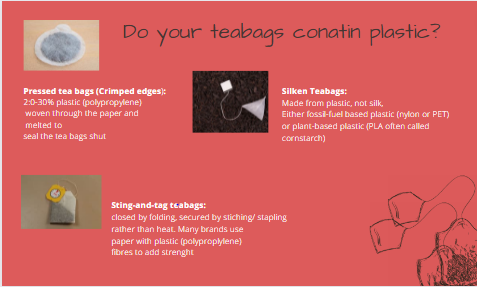Plastics and microplastics are prevalent in our natural environment and now in your cup of tea.
Dinshay Luthiya has been a tea enthusiast for years, which gradually turned him into a tea sommelier by profession in 2021. He launched his own company, Kefi organics in Pune. “My understanding of tea developed once I realized what I drink almost every day is plastic,” he said.
“If I recall correctly when I bought a lot of high-quality tea from different brands in India as well as other western regions like Canada and UK, every brand used the same kind of microplastic product, the nylon bag, because that was the best material that could effectively brew the whole leaf.”
In his research of the nylon pyramid tea bag, Dinshay explained that a new study by MC Gill University stated the steeping of one plastic tea bag at brewing temperatures (95°c) released approximately 11.6 billion microplastics and 3.1 billion nanoplastics. The released particles matched the original teabags (nylon and polythene terephthalate).
Harshada Bansal, founder of a tea company said “the majority of people in our country still drink tea. As far as the Gen Z and millennial generations are concerned, 25-35 percent of the population of the country uses tea bags every day, and five to seven percent of them use higher grade products such as whole leaf teas in nylon tea bags, commonly known as pyramid teabags.” She also said that tea bags are in high demand because most people are looking for easy ways of consumption as they are busy in their jobs and lives.
According to a report, Britons get through 61 billion tea bags a year, enough to cover almost 31,000 football pitches. A poll of 2,000 tea drinkers found they each use an average of four tea bags a day for their cups of tea. This is a total of 1,460 each year. Almost 167 million tea bags are binned or composted every day across the UK.
Minal Mittal, an AI engineer working towards sustainable innovation, said that “If there are 50 lakh people in a state and they all drink two to three cups of tea every day, the amount of teabag waste will end up either being burned or dumped. When burned, they cause a lot of air pollution; when dumped, they won’t decompose, and many of them are dumped into open drains, which then enter water bodies.”
Shritha KP, a resident of Jayanagar said that she was a regular teabag user and she prefers them due to their easier convenience. “I consume them on a daily basis. Now that I am aware of the presence of microplastics, I wouldn’t say it will be easy to switch to more sustainable tea bags. But, I will certainly do my best to find a better alternative,” she added.
Harika, a resident of Marathahalli, says, as a working woman, “I collected bags to save time and use them every day.” However, when she found out that tea bags contained microplastic, she was surprised at how much she consumed in one cup. “Considering how harmful they are, I will try to switch to loose tea,” she added.

Environment and Health
Explaining their effect on health, Satyajeet Gupta, a PhD researcher at the Centre for Ecological Sciences, Indian Institute of Science (IISc), said that microplastics in teabags being a new area of research, few pieces of evidence have proved the particles’ interaction with the immune system. They basically induce toxins and various chemicals into the human and even animal bodies. The main danger arises when the plastic particles start accumulating in the body,” he said. Plasticizers are substances added to teabags to increase their flexibility, transparency, durability, and longevity. Many studies have proved the link between cancer and the toxicity of plastic tea bags.
Pooja Naik, Project Assistant at Karnataka State Pollution Control Board, said that a majority of the population in India drinks tea, and at least 35 percent use tea bags for it. “Consumption of tea is high, and tea bags have become the most portable way to carry it. This could create a dump house to already existing unmanaged waste,” she said.
She explained that chlorine is used to bleach the teabags during manufacturing. “We are affected by everything harmful to the environment. A build-up of these in our bodies may cause cancer, imbalances, and neurological problems,” she added.
Dinshay said that there have been studies that prove if someone consumes tea through these teabags every day for a long period of time beyond five years, they can have disturbed hormone levels.
According to the American Chemical Society (ACS), when the World Health Organisation (WHO) researchers tested water brewed with plastic tea bags on water fleas, the fleas survived, but showed “some behavioural and anatomical abnormalities.”
The WHO study stated that microplastics may pose hazards due to three sources – the particles themselves, chemicals in the particles, and microorganisms that may attach and colonize on microplastics, called biofilms.
Sustainable Approach
Minal said that stick infusers, basket infusers, and tea balls are the best sustainable alternatives. “We, as individuals, should switch to wholesale loose leaf with steel infusers so that we can avoid bags entirely. Utilizing organic leaf wraps can be one of the sustainable solutions when it comes to packaging,” she said.
Purchase of items like salt packets and rice bags add to indirect consumption of microplastics in our day to day life, that difficult to assess and avoid, said Harshada. However, teabags are avoidable, and one way to do so is to develop a product that does not contain microplastics or nylon. “Handsewn cotton tea bags made from unprocessed cotton can be the best alternative,” Harshada added.
With hand-sewn cotton teabags, the entire process is manually done filled with whole leaf teas and they taste the same as when brewed as whole leaf tea which makes it cost-effective for manufacturing industries or any tea manufacturer.



